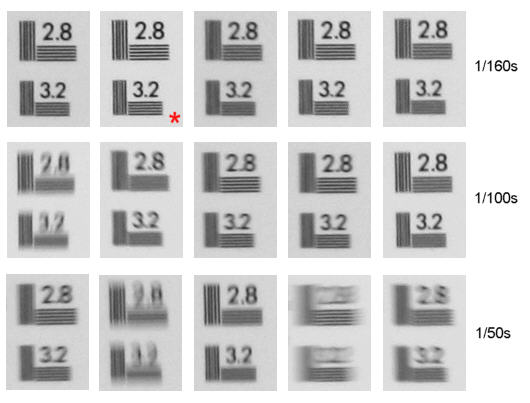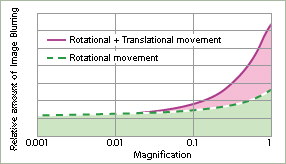

How Slow can you HandHold a Camera?
There's an often cited rule in photography that in order to get sharp images when shooting a camera hand held (rather than on a tripod), you have to use a shutter speed which is (1/focal_length) seconds. So for a 100mm lens you'd need to shoot at 1/100s or faster, for a 300mm lens, 1/300s or faster and for a 500mm lens, 1/500s or faster.
Does this rule work, does it apply to all formats and where does it come from?
The answers to the first two questions are "sometimes" and "no", but the third question requires a longer answer - and the answer will also address the first two questions!
When you are handholding a camera, it's never perfectly still. It will be tilting up and down and swinging left and right due to involuntary movements of your muscles. It may also rotate (clockwise or anti-clockwise). How much it moves depends on a lot of things. The weight of the camera and lens, whether you are standing, kneeling or resting against a doorway and possibly how many cups of coffee you drank that day! In addition to these movements you can also move the camera vertically up and down, horizontally left and right and backwards and forwards.
So we have these "degrees of freedom":
- Pitch - camera tilts up and down.
- Yaw - Camera swings to the left and right
- Roll - Camera rotates clockwise and anti-clockwise
- Vertical translation - camera stays level and moves up and down
- Horizontal translation - camera stays level and moves to the left and right
- Axial translation - camera moves back and forth
Let's look at the first three first, because unless you're doing macro work (which I'll deal with later), they are the only three that really matter, and in fact only the first two are of any practical importance, and they are Pitch and Yaw (angular rotation up and down and left and right).
Let's assume on average that while holding the camera as still as you can, in fact you are swinging the camera though small angles at an average rate of, say, 0.8 degree per second. The amount of movement of the image on the sensor will depend on the focal length of the lens. You can easily see this for yourself when you compare the view handholding a 20mm wideangle lens (very steady image) to that when handholding a 500mm lens (the image moves at lot).
For a 100mm lens, a 0.8 degree swing will move the image through about 1.6 mm, which will cause considerable blurring. If you want no significant blurring, you'd want to hold image motion down to something like 16 microns for an 35mm frame (16 microns is about 1/2 the value of the circle of confusion and is equal to 16/1000mm). Since the image moves though 16 microns in 1/100s, you'd want to shoot at a shutter speed of 1/100s or faster.
Now this corresponds to the 1/focal_length rule because I chose the 0.8 degree/sec movement rate so I got the right answer! Obviously the rate at which the camera moves around will vary. It times it will be slower, at times it may be faster, for some people it may be slower, for some people faster. That's why the "rule" is only a guide. It's an average based on the experience of a large number of people. Sometimes 1/100s will be fast enough to give a sharp image, sometimes it won't be. Sometimes you may get a sharp image at 1/50s or 1/25s, though the probability of getting a sharp image drops rapidly at slower shutter speeds. However on the average, if the shutter speed is 1/focal_length or faster, you have a good chance of a sharp image.

Handheld shots, EOS 40D, 100mm lens
The set of images above show these effects quite well. They are 100% crops from sets of 5 successive images shot with an EOS 40D using a 100mm lens. As you can see, as the shutter speed drops, the probability of getting a sharp image decreases, but even at 1/160s not all the images are equally sharp. They might all be "OK", certainly for small prints, but they're not all as sharp as they would be if a tripod had been used. The image marked with a red "*" is the only one that's as sharp as a tripod shot.
So now we've answered two questions: Where does the 1/focal_length rule come from (see above) and does the rule work (often it does, sometimes it may not). Now let's look at a third question, "Does format size matter"?
Yes it does, and here's why. We judge sharpness based on a print, not based on the image formed on film or a digital sensor. That image must be enlarged to make a print. For 35mm film and full frame sensors, to make an 8"x12" print the original image must be enlarged by a factor of 8 (since the image itself is about 1"x1.5"). However for a Canon APS-C sensor (which is smaller) it must be enlarged by a factor of 12.8x. If we want the same degree of sharpness in the print, the image on the sensor must start out sharper. In fact for Canon APS-C sensors, 1.6x sharper. So instead of allowing the image to move by 16 microns, we can only allow it to move by 10 microns. Since we can only allow 10 microns of image movement, we now need to use a shutter speed of 1/160s rather than 1/100s. So smaller formats need faster shutter speeds if we want equally sharp prints of the same size. Again though, even using a 100mm lens and a shutter speed of 1/160s, you are very unlikely get every shot as sharp as it would be if you used a tripod.
The Macro Case
 As I mentioned above, pure vertical and horizontal translational movement of the camera doesn't materially affect image sharpness as long as you're not in the macro range. The reason for this can be understood in terms of image magnification. Let's say you're taking a shot of a building that's 100m away and you're using a lens with a focal length of 100mm. The magnification you get is (approximately) given by (focal-length/distance), which in this case is (100/100,000) = 1/1000th. In terms of camera movement this means that if you keep the camera level and raise the camera vertically by 1", the image will move by only 1/1000 of that amount, i.e. 1/1000". 1/1000" is so small that it would not affect the image sharpness in any meaningful way, so even large amounts of camera translation (movement left or right or up or down without tilting or rotating) don't matter much when magnification is low.
As I mentioned above, pure vertical and horizontal translational movement of the camera doesn't materially affect image sharpness as long as you're not in the macro range. The reason for this can be understood in terms of image magnification. Let's say you're taking a shot of a building that's 100m away and you're using a lens with a focal length of 100mm. The magnification you get is (approximately) given by (focal-length/distance), which in this case is (100/100,000) = 1/1000th. In terms of camera movement this means that if you keep the camera level and raise the camera vertically by 1", the image will move by only 1/1000 of that amount, i.e. 1/1000". 1/1000" is so small that it would not affect the image sharpness in any meaningful way, so even large amounts of camera translation (movement left or right or up or down without tilting or rotating) don't matter much when magnification is low.
However now consider the macro case where you are at 1:1 (1x) magnification. Now if you move the camera up, down, left or right by even 1mm, the image will also move 1mm and so will be very blurred. Even a movement of 1/100" (25 microns) would be enough to result in detectable image blurring. Obviously in the macro case you have to have the camera steady and prevent it from both rotational and translational motion.
Keeping the Lens (and Image) steady
The best solution is to use a tripod of course. However the title of this article is about handholding a lens, so if you don't want to use a tripod, your other alternative is either to use an image stabilized lens if you shoot with Nikon or Canon or to use an image stabilized body if you shoot with Sony, Olympus or Pentax. Either one can give you up to about 3 or 4 stops of added stability in the best case, so you could get images as sharp at 1/20s with stabilization as you could at 1/160s without it! Even in the worst case optical stabilization should give at least 1 or 2 stops of additional stability.
The Canon and Nikon systems use small gyroscopes ("gyros") in the lens to sense rotation (pitch and yaw) and use this signal to move a lens group in a way to compensate for the image movement that this rotation would cause. The Pentax, Sony and Olympus systems use similar sensors (this time in the camera body) and move the sensor in order to compensate for image movement.
Lens based stabilization has the advantage that the viewfinder image is also stabilized and you can get stabilization over a wider range of motion then the body based system. The body based system has the advantage that it is applied for any lens, not just those lenses with optical stabilization built into them. This allows the use of a wider range of lenses, plus it lowers the complexity (and hopefully therefore the cost) of the lenses.
In the Macro range, as described above, translational movement is important and gyro sensor systems only compensate for rotation. Recently Canon have introduced a hybrid stabilization system in their new EF 100/2.8L IS USM Macro lens. This lens can not only compensate for rotation (which is important at normal focus distances), but it can also compensate for translation (which is important for macro work). It uses both gyros to detect angular rotation and accelerometers to detect translational motion. At present (winter 2009), the Canon 100/2.8L IS USM Macro is the only lens which can do this.
If you found this article interesting, please tell others about it...
Image stabilized lens reviews:
- EF 100-400/4.5-5.6L IS USM - best stabilized telephoto zoom
- EF 24-105/4L IS USM - fast and sharp general purpose zoom
- EF 70-300/4-5.6 IS USM - great value telephoto zoom
- EF-S 17-85/4-5.6 IS USM - very useful general purpose lens
- EF 70-200/2.8L IS USM - the best mid-range telephoto zoom (but expensive)

